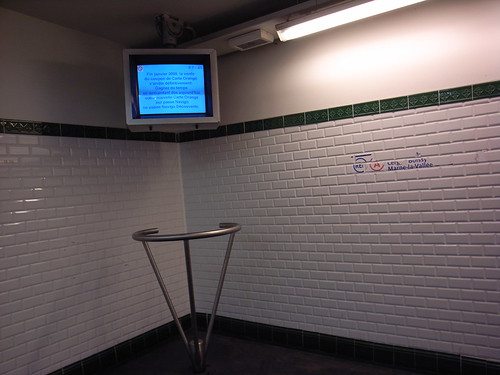User experiences deliverables
 People interested in design process and deliverable should read "User Experiences Deliverables". The blogpost summarizes a wide array of elements that can be used over the course of a design project. The treasure map (.pdf) offers a good summary.
People interested in design process and deliverable should read "User Experiences Deliverables". The blogpost summarizes a wide array of elements that can be used over the course of a design project. The treasure map (.pdf) offers a good summary.
Why do I blog this? One month ago, I blogged about the different representations of design process as compiled by Hugh Dubberly. The description of design deliverables is also an interesting topic in conjunction with process descriptions. This is both material to rethink my own work process and a good content to discuss in class with students.
Design add-on
 A magnifying glass added to shopping carts in my grocery store in Geneva. An interesting add-on for shoppers who may need this feature. Will help to perceive some details not easy to see.
A magnifying glass added to shopping carts in my grocery store in Geneva. An interesting add-on for shoppers who may need this feature. Will help to perceive some details not easy to see.
It's funny to see that while in some places shopping carts are enhanced with rfid reader, this shop has chosen another design direction to help its consumers.
Console game as a social place
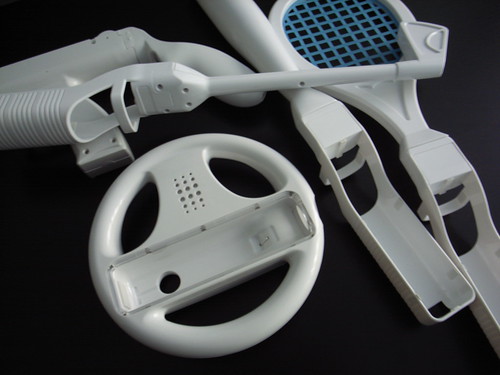 It seems that we finally have some good research material about the user experience of the Wii. Working on this topic for two years for a client, I was amazed by the lack of paper concerning how players use the Nintendo console and its gestural interaction devices. It seems that "Wii All Play: The Console Game as a Computational Meeting Place by Amy Voida & Saul Greenberg is a good step towards the understanding of Wii UX.
It seems that we finally have some good research material about the user experience of the Wii. Working on this topic for two years for a client, I was amazed by the lack of paper concerning how players use the Nintendo console and its gestural interaction devices. It seems that "Wii All Play: The Console Game as a Computational Meeting Place by Amy Voida & Saul Greenberg is a good step towards the understanding of Wii UX.
The paper reports the results of a field study that focused on examining collocated group behavior. What is interesting here is the analysis of console gaming as a "computational meeting place for a diverse population of gamers": a family entertainment device of some sort. The main claim of the paper, supported by results from the field study lies in showing that what makes video-game fun is not the game itself but the "sociability that surrounds the gameplay".
I won't enter the result details, but the paper shows the different roles the console has in being "a meeting place":
"Console games serve as:
- a meeting place for social interaction
- a meeting place with porous boundaries
- a meeting place for gamers with varied levels of expertise
- a meeting place for gamers with varied preferences for gaming genres & styles of gameplay
- a meeting place between interpersonal relationships and the competition of gameplay
- a meeting place between gaming and its stereotypes, and
- a meeting place between adults-as-parents and adults-as-gamers"
The paper describes each of these roles by showing various examples. Any interested reader should read them btw, things such as "Anything electronic I would do" are gems!
The part about design recommendation is also highly worthwhile, see some excerpts:
"Games designed to provide a meeting place for groups of gamers should undertake some combination of the following:
- Allow gamers to rotate in and out of the gameplay easily
- Make use of input devices with intuitive mappings (button-based input devices were less well-liked by the gamers in this study than gestural and physical input devices)
- Combine a shallow learning curve for novice gamers with more challenging gameplay for more expert gamers
- Provide modes of gameplay that allow players with different skill levels to play with or against each other
- Explore modes of gameplay that alter the game in significant ways for different groups of players so that the owner of the console or the game does not always have an advantage
- Provide modes of play that downplay competition between players (e.g., fostering non-serious competition or competition between the gaming group as a whole and the computer)
- Appeal to gamers with different gaming preferences within a single game (e.g., by offering compelling gameplay for a gamer who is typically drawn to strategy games while also appealing to other gamers who may be drawn to games with more challenging puzzles or immersive stories)
- Foster audience participation or an otherwise enjoyable audience experience
- Explore ways of extending the social experience of group console gaming into the larger ecology of shared media."
Why do I blog this? lot of material here for a new research vector about the Nintendo Wii. I am really glad to have found a reference about this topic. Will try to accumulate material about this before hiring an intern to help on this. Plus, I like the message here, about the "computational meeting place", well-supported by the data analysis.
Awareness, visibility and Twitter
Looking at the webosphere, it's funny how certain topics appear to be new and shiny when they exist for quite a while. The notion of "ambient awareness" is one of these terms that you hear here and there as if it was brand new. It generally refers to the possibility to stay tuned with what your contacts/social network is doing, will do or think. A social radar of some sort, enabled by microblogging platforms such as Twitter or Jaiku (or Facebook status). What's intriguing is that the whole discourse about these services neglect the large array of research about "awareness". In the last twenty years, authors such as Paul Dourish, Saul Greenberg or Thomas Erickson have produced a lot of material, studies, guidelines, theories and recommendations about this. In this blogpost, I wanted to get back to this issue since it's important to describe what has been done in the past about it, before looking at the Twitter example. A brief recap of the research about Awareness
All started in a research domain called "Computer-Supported Collaborative Work", the branch of Human-Computer Interaction which looks as how technologies can support and enrich collaboration practices. Now this field is more and more concerned by other contexts than work (such as education or games) so we can perhaps use the term "social computing" to make it broader. The last twenty years of research in this field acknowledges the relationship between collaboration "efficiency" and the visibility of group members’ activities across time and space; namely enabling what has been called awareness by the research community (see for example Dourish and Bellotti, 1992, Dourish and Bly, 1992; Gutwin et al., 1995, Erickson and Kellogg, 2000).
Historically, the notion of awareness has been drawn from two domains. On one hand, it emerged from field studies of collaborative work in co-present work settings (Heath, & Luff, 1992; Heath and Hindmarsh, 2000), which focus on how workers systematically coordinate their activities by relying on changes in the local context as well as on their partners visible contributions. In this context, awareness is seen as the ‘mutual visibility’ of each other’s actions, conveyed by the continuous broadcast of information generated during the course of action. Of course, as Heath and Luff (1992) point out, this mutual visibility/observability of actions relies on the active practice of team members who make their own actions ‘visible/observable’ to the others. On the other hand, the notion of Awareness appeared in computer science, as a concept relevant to design collaborative technologies (Dourish and Belloti, 1992; Gutwin et al, 1995; Erickson and Kellogg 2000; Gutwin and Greenberg, 2002). As opposed to the richness of a copresent situation, geographically dispersed collaboration engages participants in joint activities with a low visibility of each partner’s contribution to the main goal of the group. This is why ‘awareness interfaces’ or ‘awareness tools’ have been designed to convey more visibility, showing group members representation and actions.
As stated by Schmidt (2002), the term awareness is highly equivocal in the sense that it is used in a lot of different ways and is often qualified by many adjectives like ‘general awareness’ (Gaver, 1991), ‘workspace awareness’ (Gutwin and Greenberg, 2002) or ‘informal’ or ‘passive’ awareness’ (Dourish and Belloti, 1992). Definitions indeed range from knowing who is present in the environment to the visibility of others’ actions (Heath and Luff, 1992). These limits, however, did not prevent the CSCW community from using the ‘awareness’ concept as the starting point for many original and innovative collaborative technologies. In this thesis, we will not enter into this debate about setting a proper definition but instead focus only on the awareness of people’s location in a shared environment, be it physical or virtual.
Even though awareness is a broad and blurry concept, in the epistemological sense, there are some recurrent definitions set by scholars. Among all the terms that are used in conjunction with this notion of awareness, the one that has received the most important attention is certainly the “workspace awareness” that Gutwin and Greenberg (2002) describe as “the up-to-the-moment understanding of another person’s interaction with the shared workspace” (Gutwin & Greenberg, 2002). More precisely, according to these authors, awareness refers to the perception of changes that occur in the shared environment. These authors also highlight that awareness is part of an activity, such as completing a task or working on something. The main objective of awareness is not only to perceive information but also to recognize the contextual elements required to carry out a joint activity. This is what Dourish and Belloti expresses by saying that awareness corresponds to: “an understanding of the activities of others, which provides a context for your own activity” (Dourish and Bly, 1992, p.107). These definitions emphasize the idea that awareness is meant to enrich the context of collaboration; they also implicitly state that maintaining awareness is not the purpose of an activity but instead a basis for completing the task.
Types of Awareness and usage
Starting from the previously described definitions of awareness, Gutwin and Greenberg (2002) differentiated the core components of awareness according to simple questions such as “Who, What Where, When”. According to these authors, awareness can be described in terms of the period of time it covers, conveying information about the present state of the environment (“synchronous awareness”) and or about past occurrences of events (“asynchronous awareness”), which corresponds to the “When” question.
So, to some extent:
- the "who" question corresponds to notification tools which enables to know who is contacted on your IM client.
- the "where" question corresponds to location-based services as they allow the user to be aware of his or her's contacts whereabouts.
- and so on.
Knowing what others are doing or where they are located can be useful for various reasons: simplification of communication, help people to coordinate, supports inferences regarding the partners’ intentions, know if a partner/colleague/friend needs help or just to get a vague feeling of presence (belonging to a community of friends, family...).
Awareness and Twitter
Time for more recent applications. In her paper called "The Translucence of Twitter" presented at EPIC 2008, Ingrid Erickson examines Twitter in conjunction with the aforementioned theories about awareness and visibility. The paper is a field study which examines the use of Twitter and conclude "there are certain obvious ways that Twitter showcases people’s thoughts and behaviors, but less obvious ways in which interlocutors signal their awareness of being noticed. ". The author compares the notion of Awareness as described in the work of Erickson and Kellogg (about "social translucence") and Twitter usage to show the discrepancies and alternate means of establishing awareness:
"Indirect Awareness: awareness can be evoked via Twitter, just not always in a direct manner. (...) Twitter here is a visible trigger for a host of possible awareness-oriented response mechanisms, from the completion of a work task to a physical meet up to a phone call. (...) receives a phone call because of a Twitter post he makes, this act raises his awareness that his messages are not falling on deaf ears. In turn, he is less inclined to falsify or make irresponsible posts in subsequent communications. (...) Awareness by Incident: Microblogging during a critical incident, such as inclement weather, appears to bring together individuals across community levels (i.e., perceived close and extended) out of a common need for timely information exchange. (...) Within this critical incident, Twitter became a real-time forum to make reports from respective outposts both to signal well being and to check in with others, despite varying levels of intimacy."
Why do I blog this? I am trying to sort out some ideas about microblogging platforms and theories about Awareness. Of course, one of the underlying theme I am interested in refer to mutual-location awareness and how tools such as Twitter and Jaiku engage people in new ways to discuss spatial issues.
Simplicity according to the Log Lady
Recently got back to the Twin Peaks series, I was struck by this quote form the log lady in the seventeenth episode:
"Complications set in--yes, complications. How many times have we heard: 'it's simple'. Nothing is simple. We live in a world where nothing is simple. Each day, just when we think we have a handle on things, suddenly some new element is introduced and everything is complicated once again. (...) "What is the secret? What is the secret to simplicity, to the pure and simple life? Are our appetites, our desires undermining us? Is the cart in front of the horse?""
Why do I blog this? just found this quite intriguing to think about, especially considering the whole discourse about simplicity and design.
Touch / don't touch
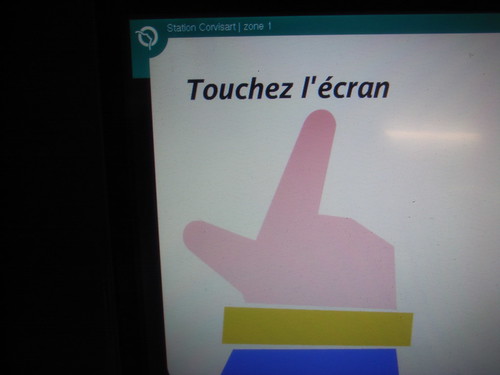 Above in Paris, below in lyon. Duality of signs to encourage or prevent people with certain norms (use of the red color...)
Above in Paris, below in lyon. Duality of signs to encourage or prevent people with certain norms (use of the red color...)
How can I not be intrigued by this odd sign that prevent people from using a specific device (a container of salt to be put on sidewalks)? This gentle "touch" hand with a crossbar to indicate the restriction.
Defensible space in the subway
Ownsership and design
"slow" in "slow innovation"
A nice read in the last issue of Design Mind (by Frog Design): "Slow Innovation: Good ideas take a long time to perfect" by David Hoffer. Taking various examples (from Edison’s cylinder phonograph invented in 1877 to its plateau-ed end in 1910 or the 80 years duration of vinyls), the author shows that there seems to be 30-plus year innovation cycles and variations. This topic is of course highly explored in the literature about the diffusion of innovation (see for instance the work by Everett Rogers). The article sums up some of the results from this literature. See for example the discussion about the users' roles in innovation ("echnology may be advancing quickly, but that doesn’t mean humans have the interest or the aptitude to adopt it right away"). But more importantly, it's the implications for business that are the most relevant here:
"For businesses, slow is often a pejorative term, but slow innovation isn’t always a bad thing. Slow change can give entrenched industries a chance to gather their thoughts and respond effectively. Is it possible that a 19th-century buggy-whip company, faced with declining sales, started fashioning steering wheel covers, gearshift handle caps, and leather seating in cars? If not, they should have, thereby turning extinction into evolution. Businesses looking to innovate must always be paying attention to disruptions (and perhaps even doing a little disrupting of their own)."
Why do I blog this? updating the material I use for the courses I will give this semester about innovation, user research and foresight.
Lessons from Sci-Fi predictions
CIO has a recent article about the lessons learned by science-fiction writer about predicting the future of technology. This journal asked authors such as Larry Niven, Robert Sawyer, Nancy Kress and Charles Stross to discuss technology-related predictions. The whole article is a good read but I point here some of the lessons:
- "Look for the goals humankind will never give up. Instant travel, instant education, longevity. Then try to guess when it will appear and what it will look like.
- Pay close attention to parasite control. There is always someone who wants the money for something else.
- You're obliged to predict not just the automobile but the traffic jam and the stranglehold on gas prices
- The trap we science and space buffs always fall into is thinking that everybody will want the things that we want, they don't; they have their own agendas, and ultimately, as in everything, it's the economy, stupid. Just because you personally want something doesn't mean there's a market for it. Just because we technically could do something doesn't mean that's how others want to see their tax dollars spent."
- We can point to extrapolations of current technological and social trends, but we can't extrapolate on the basis of stuff that hasn't been discovered yet. For example: In 1962 it was possible, just about, to see the future of integrated circuitry (and even, if you were very far-sighted, to glimpse Moore's Law and its implications), but the CD player was right out of the picture— solid state lasers lay at least a decade in the future.
- The standard advice is to be aggressive in your predictions; there's this notion that the future always comes faster than you think it will (...) But, actually, I think a lot of us underestimated social inertia, Most of us predicted a secular 21st century, and it's anything but that. The world is like a person: It doesn't change as it gets older. Rather, it simply becomes more obviously what it always was. People always liked having phones and portable music, but most people never wanted to lug a camera, or an ebook reader, or a PDA around. The future is adding functionality to those things we've already admitted into our lives, not trying to convince people they need new categories of things; the iPhone—the all-in-one device that is, first and foremost, something familiar—is the correct paradigm.
- Study the cutting edge of the specific field. Create wild cards. And then don't worry about being wrong—it's science fiction."
Why do I blog this? some good tips here and ideas to be mentioned in upcoming work about failed futures and the importance of understanding failures. It echoes a lot with the talk I've given at Design Engaged, I will maybe reshuffle this for my introduction to Lift09.
this is not a prototype
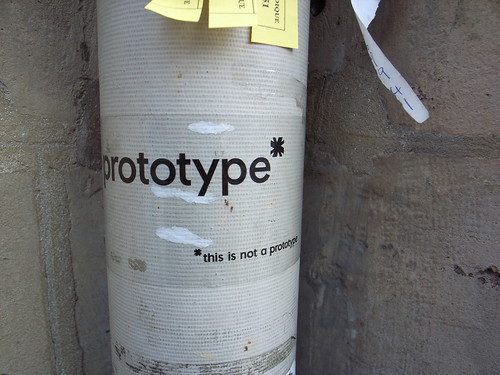 Intriguing sticker found in Paris yesterday. Surely some trendy street-art phenomenon but the observing how it's inserted in the urban fabric is very compelling, as if the city infrastructure was referred to as "this is not a prototype"... as if people needed to be aware that this pipe was real and important.
Intriguing sticker found in Paris yesterday. Surely some trendy street-art phenomenon but the observing how it's inserted in the urban fabric is very compelling, as if the city infrastructure was referred to as "this is not a prototype"... as if people needed to be aware that this pipe was real and important.
Would be funny to have this kind of sticker "everyware" (please appreciate the pun here): "this is not a prototype... and you'd better care about this urban computing infrastructure".
Slow evolution of social LBS
... as attested by this recent news which shows that Google is shutting down the mobile social network it bought few years ago (Dodgeball). Dennis tells us more about hiss perspective on the near future of social LBS:
"And just on a sidenote, the whole mobile + social space is still pretty open. Even, what?, 5 years after Alex and I launched dball in April 2004, no one is really doing anything new. Sure, Brightkite showed us "Place Snap" and Loopt's rocking "Mixx" (ha!), but no one is really thinking about this space beyond just "Twitter with whereabouts"... so maybe Naveen and I can take a stab at fixing that."
Why do I blog this? an interesting sign that that the evolution of social LBS takes time and that we're not there yet as a large market (will we ever go there anyway is also an interesting question).
About automated journeys
 A good list of papers from the Automated Journeys workshop (at Ubicomp 2008) has been put on-line recently. This event was about examining how automation reconfigure people's interactions with cities and speculate on what innovations might be to come. I unfortunately missed it, although this is a favorite topic of mine.
A good list of papers from the Automated Journeys workshop (at Ubicomp 2008) has been put on-line recently. This event was about examining how automation reconfigure people's interactions with cities and speculate on what innovations might be to come. I unfortunately missed it, although this is a favorite topic of mine.
I haven't checked all the papers but I was intrigued by the one called Automation as a Very Familiar Place written by Mads Ingstrup. Some excerpts that I enjoyed:
"The constraints set by the infrastructures supporting our journey through spaces we create are a strong determinant of how we experience those spaces and their places. We argue that rigidity of infrastructural constraints causes familiarity, and that familiarity breeds the automatic experience. (...) They are familiar because they are stable across a variety of contexts—a journey by train in Scandinavia now compared with one in Japan some hundred years ago, while not exactly the same, has some stable and defining features: the passive traveler situated in the train car, observing the landscape passing by the window. (...) What happens to our experience of journeys such as train travel if it is infested/blessed with the wave of technologies ubicomp represents—enabling people to increasingly personalize their surroundings? (...) Digital technologies that increase the opportunity for personalization may change the ways in which infrastructure influence our experiences. In particular, we raised the question of whether it makes the meaning of our experiences more personal and therefore less shared. Further we suggested that the notion of automation can usefully be analyzed in terms of where control is situated and in terms of the rigidity of its implementation."
Then "Connectability in Automated Journeys" by Shin'ichi Konomi & Kaoru Sezaki is also interesting as it uncovers a specific dimension of automated journey: connectabiliy:
"Ubicomp technologies can enable new forms of connectability in a city, and technologies for supporting connectability need to be integrated into subtle human processes. We then introduced the 6 dimensions that could be used to explore the design space for supporting connectability:
- People - things - spaces Connections can be made within and across the following categories: people, things and spaces.
- Digital - physical Connectability can be represented by using digital, physical, as well as ‘hybrid’ media.
- Explicit - implicit Connectability can suggest connections explicitly or implicitly. Connectability can be ambiguous.
- Real time - batch Connectability can be identified in real time (e.g., Lovegety) or through batch processing (e.g., post hoc analysis of GPS traces)
^
- One Time - repeated Some opportunities to connect arise only once. Others arise multiple times and even repeatedly. This dimension is also relevant to serendipity.
- Ignorability Connectability can/cannot be ignored without causing negative effects (cf. “plausible ignorability”)"
Why do I blog this? Automation is one of the dimension of technology that I find the most interesting since it's an obvious locus of research. It directly embeds the topic of human relationship to technologies given that automation is often a goal for system designers (as a substitute for human activities) and if often leads to failures and troubles.
Just-in-time feedback device
 As seen on an Air-France counter, a tactile device to get people's feedback. What is interesting here:
As seen on an Air-France counter, a tactile device to get people's feedback. What is interesting here:
- On the HCI side: The absence of screen on the device, what is important for the company is only the answers, nothing is really needed to be shown to the person who is pressing the buttons. It's a one-way interface.
- On the context side: real-time feedback that can be gained with devices like this, in context. It of course leads to wonder about the best moment to ask people's feedback when traveling: when the interaction occur OR after a while when people had some time to filter out the plus and minuses of their experience. But wait, is life only about +/-?
Update on Lift09
 A quick update on Lift09, the conference is taking shape. It's 6 weeks ahead, a good list of people registered already and the program is completed (apart from the sustainable evening event) and we are looking forward to have the whole bunch of speakers who will talk about the implications of technologies in society.
A quick update on Lift09, the conference is taking shape. It's 6 weeks ahead, a good list of people registered already and the program is completed (apart from the sustainable evening event) and we are looking forward to have the whole bunch of speakers who will talk about the implications of technologies in society.
Also, for those who want to attend the Lift conference, there's only one day left before the end of the early bird pricing. And there is still room in the open program with workshops, short speeches and discussions.
Looking forward to it! Lot of work till then anyway.
Automatic flush
Borges and maps
As described by Jorge Luis Borges in of his novel:
"... In this empire the art of cartography had reached such a perfection that a map of a single county covered a whole city, and a map of the empire that of a whole county. Finally, a point was reached when these colossal maps were no longer considered satisfactory, and the institutions of the cartographers made a map of the empire which was as large as the empire itself and coincided with it point for point. Later generations, who were less prone to practice the art of cartography, came to realize that this vast map was useless and through some neglect abandoned it to the forces of sun and winters. In the deserts of the western regions [of the empire], home to beasts and beggars, there remained dispersed ruins of the map, but otherwise there were no remains of the practice of geography in the whole land."
Why do I blog this? In this excerpt, Borges mock the utopian 1-1 cartography of the world by showing how such a mapping would be as large as what it represents. I found interesting to use this quote to demonstrate the difference between reality and what can be mapped.
LBS limits (again)
In his recent column at ACM interactions, Lars Erik Holmquist deals with two basic problems encountered by mobile social software: battery life and critical mass.
"The first may seem trivial, and more than one startup seems to simply shake it off—isn't everything in electronics getting better all the time anyway, according to Moore's law? No, this is actually a real killer. A device that pings its surroundings wirelessly with regular intervals, using Bluetooth or Wi-Fi, will drain any sensibly sized battery in a few hours at most. Continuously pulling up and reporting a GPS location can be even worse. It is highly unlikely that users will stand for carrying half a dozen replacement batteries, and barring an unprecedented breakthrough in battery technology, the only fix on the horizon is some kind of push solution based on network cell location. Unfortunately, to be useful this requires a degree of cooperation between network service providers that is still a long way off.The second issue stems less from a lack of user interest and has more to do with the extremely fragmented mobile device market. Whereas signing up for a Facebook account can be done in a matter of minutes, downloading and installing a mobile application has been lots of hard work and beyond the reach of most normal users. This might change very fast, however. With Apple's iPhone 3G and the accompanying Appstore, there is now for the first time an attractive platform and sales channel for mobile software. In response the rest of the market is likely to finally consolidate around a small number of standard operating systems (including Android, Symbian, and Windows Mobile). This means that quite soon, we will see people downloading and using social software on their phones—and those that hook into existing networks will have a head start. Already, iPhone versions of AIM and Facebook are among the Appstore's top downloads, with others such as Twitteriffic and MySpace also gaining headway."
Why do I blog this? This discussion echoes with the chapter of my locative media book which deals with the limits faced by location-based services. Both problems are highly important and limiting for the development of the field, even fifteen years after the first prototypes.
Others in public transports
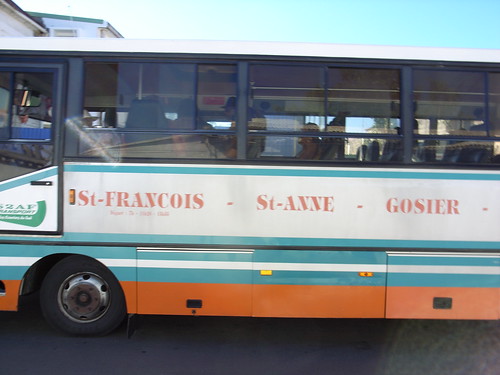 Reading books about urban sociology on the bus in Guadeloupe made me think about this quote by Georg Simmel:
Reading books about urban sociology on the bus in Guadeloupe made me think about this quote by Georg Simmel:
"Before the development of buses, railroads, and trams in the nineteenth century, people had never been in a position of having to look at one another for long minutes or even hours without speaking to one anothe"
Georg Simmel, Soziologie: Untersuchungen Über Die Formen Der Vergesellschaftung (Berlin: Duncker & Humblot, 1958), 486


